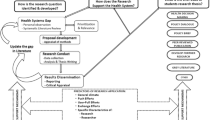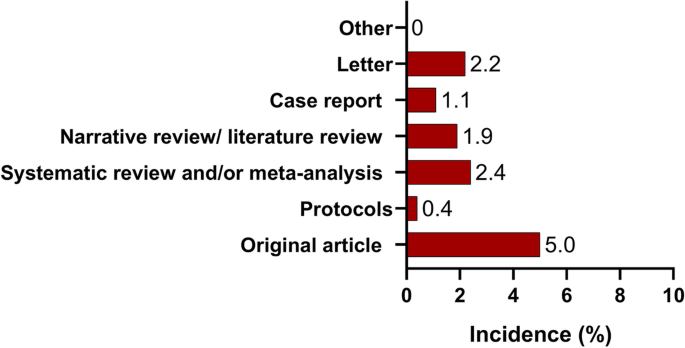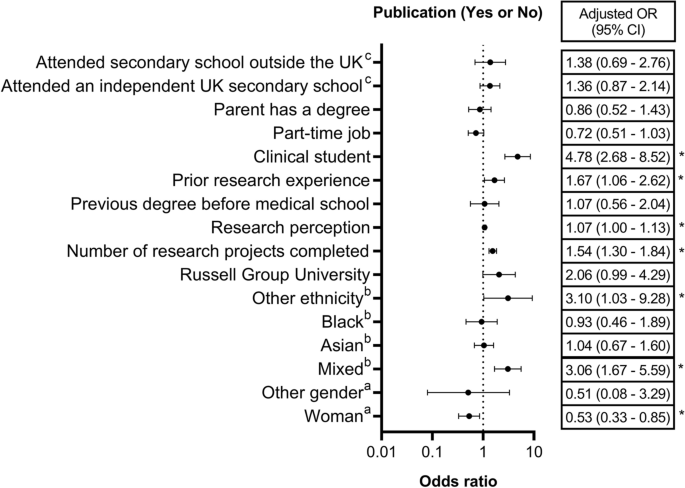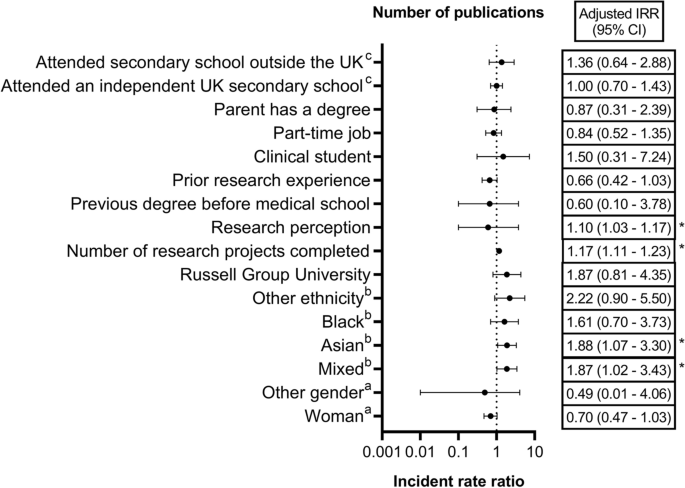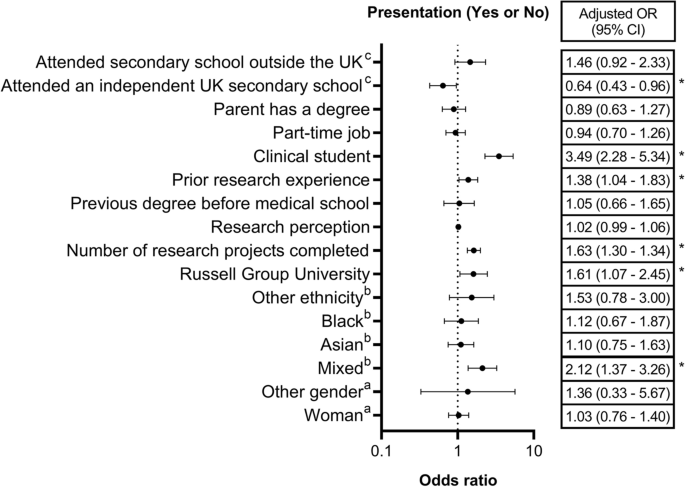Abstract
Background
The number of academic clinicians in the UK is declining and there are demographic inequalities in the clinical-academic workforce. Increased research productivity by medical students is believed to reduce future attrition in the clinical-academic workforce. Thus, this study investigated the association between student demographics and research productivity amongst UK medical students.
Methods
This is a national multicentre cross-sectional study of UK medical students in the 2020/21 academic year. We appointed one student representative per medical school, and they disseminated a 42-item online questionnaire over nine weeks, through departmental emails and social media advertisements. The outcome measures were: (i) publications (yes/no) (ii) number of publications (iii) number of first-authored publications (iv) abstract presentation (yes/no). We utilised multiple logistic and zero-inflated Poisson regression analyses to test for associations between the outcome measures and predictor variables at a 5% significance level.
Results
There are 41 medical schools in the UK. We received 1573 responses from 36 UK medical schools. We failed to recruit student representatives from three newly formed medical schools, whilst two medical schools prohibited us from sending the survey to their students. Women had lower odds of having a publication (OR: 0.53, 95% CI: 0.33–0.85) and on average had fewer first-author publications than men (IRR: 0.57, 95% CI: 0.37–0.89). Compared to white students, mixed-ethnicity students had greater odds of having a publication (OR: 3.06, 95% CI: 1.67–5.59), an abstract presentation (OR: 2.12, 95% CI: 1.37–3.26), and on average had a greater number of publications (IRR: 1.87, 95% CI: 1.02–3.43). On average, students who attended independent UK secondary schools had a higher rate of first-author publications compared to those that attended state secondary schools (IRR: 1.97, 95% CI: 1.23–3.15).
Conclusion
Our data suggest that there are gender, ethnic and socioeconomic inequalities in research productivity among UK medical students. To tackle this, and potentially improve diversity in clinical academia, we recommend that medical schools should facilitate targeted high quality research mentorship, funding and training, especially for under-represented-in-medicine students.
Similar content being viewed by others
Background
The phrase 'clinical academics' typically describes clinicians who are allotted protected time in their work schedules to engage in scholarly/research pursuits. The clinical academic role was created to facilitate the application and translation of research findings into clinical practice [1]. There has been a decline in the number of clinical academics in the United Kingdom (UK) [1]. In addition, the ethnic and gender profile of the clinical academic workforce is not reflective of the wider population of licensed doctors. Female clinicians and those from black, Asian and minority ethnic backgrounds have reduced access to research opportunities, with disproportionately low representation in the academic workforce and research leadership [1, 2].
Engaging medical students in research activities during their medical training could mitigate the declining number of academic clinicians [3]. Some authors argue that research experiences are incomplete unless they result in the dissemination of knowledge, usually through peer-reviewed publications and presentations at scientific meetings [4]. Moreover, medical students who publish their research are more likely to be scientifically active after graduation, thus reducing future attrition in the clinical academic workforce [5,6,7].
Differential attainment appears at medical school and persists after graduation [8]. Therefore, it is possible that the ethnic and gender imbalance seen in the clinical academic workforce is associated with the research experience of students in medical school. Tackling this inequality is important to ensure patients benefit from a diverse healthcare workforce [9, 10]. Hence, our study aims to investigate the associations between student demographics and research productivity among UK medical students. In this study, research productivity is defined as the product of research activities, namely publications and abstract presentations.
Methods
This national multi-centre cross-sectional study received ethical approval from the Faculty of Health Research Ethics and Integrity Committee, University of Plymouth on 9 February 2021 (Ethics approval reference: 2570) and was conducted in line with the published protocol [11]. The participants were medical students aged 18 years or older who were enrolled in medical schools listed in the UK’s Medical Schools Council at the start of the 2020/21 academic year. All participants provided informed consent.
A 42-item questionnaire was created on Qualtrics™ based on literature findings [3, 12,13,14,15,16,17,18,19,20,21,22] and feedback from regional leads across 36 UK medical schools (Supplementary material 1). The questionnaire was distributed to the medical students using the UK National Research Collaborative Model, utilising regional leads to aid with survey dissemination Model [23]. We invited medical students from all UK medical schools to apply for regional leadership positions. The selected regional leads for each medical school were then tasked with sharing the online questionnaire with their respective medical student bodies through departmental e-mails and advertisements on student groups/forums across various social media platforms, with data collected over 9 weeks (22 March 2021 – 23 May 2021). At the time of this study, there were 41 medical schools in the UK. We were unable to recruit regional leads from three newly formed medical schools (University of Lincoln, University of Sunderland, and Edge Hill University). Two medical schools (University of Nottingham and University of Leicester) prohibited us from sending the survey to their students because they only allow surveys distributed directly from the UK Medical Schools Council.
We used the ‘RelevantID’ and ‘prevent multiple submissions’ features of Qualtrics™ to identify and prevent duplicate responses. The responses flagged as duplicates by Qualtrics™ were excluded from our analysis. Also, we excluded survey responses that were started but not completed by the respondents.
Statistical analysis
Statistical analyses were conducted on Stata 17 software (StataCorp 2021). Frequencies were presented as both absolute numbers and percentages. Our outcome measures were the students' research output based on work(s) done since the beginning of their medical training: (i) PubMed-indexed publication (yes or no); (ii) Number of PubMed-indexed publications (excluding collaborator-status); (iii) Number of first-author PubMed-indexed publications; and (iv) abstract presentation at national/international conferences.
We investigated the following factors as predictors of the outcome measures: gender, ethnicity, number of research projects completed since starting medical school, perception of research, degree qualification prior to medical school, research experience prior to medical school, stage of medical training, part-time job, parental educational attainment, the type of secondary school attended (state school vs independent/private school vs secondary school outside the UK), and the type of university (Russell Group vs non-Russell Group). The Russell Group (Supplementary Material 1) is a self-selected association of 24 leading research-intensive universities in the United Kingdom, that are known for their high levels of research activity, strong teaching and learning environments, and commitment to innovation and engagement with industry and government. ‘Age’ was excluded as a predictor variable due to multicollinearity, while academic performance was excluded as a predictor variable because the response rate was less than 80%, as planned in our protocol [11].
We used cluster-robust standard errors in our analysis to account for student clusters within each university. Binary logistic regression was utilised to test for associations between the predictor variables and the following outcome measures: Publication (yes or no) and presentation (yes or no). Zero-inflated Poisson regression was utilised to test for associations between the predictor variables and the number of first-authored publications and the total number of publications. As planned in our protocol [11], we controlled for all the predictor variables in our multiple regression analyses. A p-value < 0.05 at 95% confidence interval was considered statistically significant.
Results
Demographics
At the time of this study, there was 42190 medical students in the UK [24]. We received 1797 responses, of which 154 responses were incomplete and excluded. Qualtrics™ identified 70 responses as duplicates, and these were excluded from our analysis. Of the 1573 valid responses collected, 66.0% (n = 1038) of the respondents were women, 32.5% (n = 512) were men, 1.1% (n = 17) identified as other, and 0.4% (n = 6) preferred not to indicate their gender (Table 1). This contrasts with the population of UK medical students, which comprises of 55% women and 45% men [24]. Most of our respondents were White (n = 798, 50.7%) or Asian (n = 411, 26.1%) (Table 1). Responses were obtained from thirty-six medical schools across the UK. Due to the inability to track the survey distribution, it was not possible to calculate a response rate. However, non-response bias was minimised by ensuring the questionnaire was disseminated through a range of platforms.
PubMed-indexed publications
One hundred and forty-five students (9.2%) had at least one PubMed-indexed publication. Original articles (5%) and systematic review/meta-analyses (2.4%) were the most common publications authored by the respondents (Fig. 1).
Multiple regression analysis (Table 1, Fig. 2) indicated that gender (p = 0.032), ethnicity (p < 0.001), the number of research projects conducted by the student (p < 0.001), perception of research (p = 0.038), prior research experience (p = 0.028), and stage of training (p < 0.001) independently influenced the odds of having at least one publication.
Compared to men, women had a 47% decrease in the odds of having at least one publication (adjusted OR: 0.53, 95% CI: 0.33 – 0.85). Compared to ‘white’ students, ‘mixed ethnicity’ students (adjusted OR: 3.06, 95% CI: 1.67 – 5.59) and ‘other ethnicity’ students (adjusted OR: 3.10, 95% CI: 1.03 – 9.28) had 3.06 times and 3.10 times greater odds of having at least one publication, respectively. There were no statistically significant differences between ‘white’ students and black/Asian ethnicities. Students in their clinical years (‘clinical-years students’) had 4.78 times greater odds of having a publication compared to ‘pre-clinical students’ (OR: 4.78, 95% CI: 2.68 – 8.52).
A higher number of completed research projects unit (adjusted OR: 1.54, 95% CI: 1.30 – 1.84) and a more positive belief in the value of research (adjusted OR: 1.07, 95% CI: 1.00 – 1.13) were associated with 54% and 7% increase, respectively, in the odds of having at least one publication. Students with prior research experience (before medical school) had 1.67 times greater odds of having a publication compared to those without prior experience (adjusted OR: 1.67, 95% CI: 1.06—2.62).
Number of PubMed-indexed publications
Multiple regression analysis (Table 2, Fig. 3) indicated that the number of research projects conducted by the student (p < 0.001) and the student’s perception of research (p = 0.003) independently influenced the number of PubMed-indexed publications authored by the student.
For each additional research project conducted by a student, there were 1.17 times more PubMed-indexed articles published (adjusted IRR: 1.17, 95% CI: 1.11 – 1.23). A unit increase in the student’s perception of research was associated with 1.10 times increase in the rate of publication (adjusted IRR: 1.10, 95% CI: 1.03 – 1.17).
Overall, ethnicity was not a statistically significant predictor of the number of PubMed-indexed publications. However, we demonstrated that mixed-ethnicity students (adjusted IRR: 1.87, 95% CI: 1.02 – 3.43) and Asian students (adjusted IRR: 1.88, 95% CI: 1.07 – 3.30) had a rate 1.87 and 1.88 times greater than white students for the number of PubMed-indexed publications respectively.
Number of first-author PubMed-indexed publications
Multiple regression analysis (Table 3, Fig. 4) indicated that gender (p = 0.020), the number of research projects conducted by the student (p < 0.001), the student’s perception of research (p < 0.001), completing a degree qualification before medical school (p = 0.001), and the type of secondary school attended (p = 0.018) independently influenced the number of first-author PubMed-indexed publications published by the student.
The rate of first-author publications among women was 0.57 times lower compared to men (adjusted IRR: 0.57, 95% CI: 0.37 – 0.89). Compared to the students that attended UK state secondary schools, those that attended independent UK secondary schools had a rate 1.97 times greater for first-author publications (adjusted IRR: 1.97, 95% CI: 1.23—3.15). Compared to other students, those that completed a degree qualification before medical school had a rate 0.30 times lower for first-author publications (adjusted IRR: 0.30, 95% CI: 0.15—0.61).
For every extra research project conducted, students published 1.13 times more first-author PubMed-indexed articles (adjusted IRR: 1.13, 95% CI: 1.08 – 1.19). A unit increase in the student’s research perception was associated with 1.17 times increase in the rate of first-author publications (adjusted IRR: 1.17, 95% CI: 1.09 – 1.26).
National/international presentations
Three hundred and forty-two students (21.7%) had at least one oral/poster presentation at national/international level.
Multiple regression analysis (Table 4, Fig. 5) indicated that ethnicity (p = 0.019), university type (p = 0.024), the number of research projects conducted by the student (p < 0.001), prior research experience (p = 0.025), stage of training, and the type of secondary school attended (p = 0.029) independently influenced the odds of having at least one presentation at national/international level.
Compared to ‘white’ students, ‘mixed ethnicity’ students had 2.12 (adjusted OR: 2.12, 95% CI: 1.37 – 3.26) times greater odds of having at least one presentation. There were no statistically significant differences between ‘white’ students and black/Asian/other ethnicity students. Those that attended independent UK secondary schools compared to state UK secondary schools had a 36% decrease in their odds of having at least one presentation (adjusted OR: 0.64, 95% CI: 0.43 – 0.96).
Clinical students had 3.49 times greater odds of having at least one presentation compared to preclinical students (adjusted OR: 3.49, 95% CI: 2.28 – 5.34). Those with prior research experience (adjusted OR: 1.38, 95% CI: 1.04 – 1.83) and the students at Russell Group universities (adjusted OR: 1.61, 95% CI: 1.07 – 2.45) had 1.38 times and 1.61 times greater odds of having a presentation compared to their counterparts, respectively. A unit increase in the number of research projects completed was associated with a 63% increase in the odds of having at least one presentation (adjusted OR: 1.63, 95% CI: 1.34 – 1.99).
Discussion
In this study, we investigated the self-reported factors influencing research productivity (publications and presentations) amongst students across 36 UK medical schools. We found that gender, ethnicity, type of secondary school attended, number of research projects completed, perception of research, research experience before medical school, and stage of medical training influenced the publication and presentation practices amongst medical students.
In corroboration with the literature [3], our study demonstrates that compared to men, women were less likely to have a publication and on average, had fewer first-author publications. This is consistent with the generalised gender gap in the authorship of academic medical articles [25]. The quality of research mentorship received by a student has a substantial influence on their research productivity [26]. Previous studies have reported that women are less likely to work with successful research mentors [26, 27] and that women may receive inferior mentoring [28, 29], but it is unknown if this is because women are less likely to approach successful research mentors or are more likely to be rejected by these mentors [26]. Hence, facilitating the selection of good quality research mentors for women may improve their research productivity in medical school [30].
We found that compared to white students, those that identified as mixed ethnicity were more likely to have a PubMed-indexed publication and abstract presentation as well as a greater number of publications. Homophily is well recognised in medical education [31, 32], and it has been reported that people of similar ethnicity are more likely to co-author scientific papers together than with people of other ethnicities [33]. Some authors report that although most people who are of mixed ethnicity identify as being bi- or multi-racial, some may identify themselves as mono-racial in some contexts [34, 35]. Possibly, the racial fluidity of mixed-race students enables them to form social networks with a diverse group of peers and research mentors [36]. Some authors have reported an association between medical students’ social networks and their academic performance [31], and this is a possible explanation for the greater level of research productivity amongst mixed race students. Encouraging underrepresented minority students to partake in funded summer studentships is reported to improve publication rates in this group [37], and this could mitigate the ethnic gap in the research productivity found in our study.
Compared to preclinical students, the students in their clinical years of training had greater odds of having a publication and an abstract presentation. This is similar to findings in the literature, and this could be attributed to greater time allowance, more attainment of research-specific skills and more exposure to research mentors over the years [4, 16, 38, 39]. In addition, we found that attending a Russell Group (research-intense) university increases the odds of having an abstract presentation but does not influence the publication metrics. Previous studies reported that ‘research-elite’ universities offer more opportunities for student research [40] with these students seemingly having a more satisfactory research training experience [17].
On average, the students that attended an independent/private UK secondary school had approximately twice the number of first-author publications of those that attended UK state schools. This finding mirrors previous reports that the odds of entering a UK medical school are doubled by attending an independent UK secondary school rather than a state school [41]. This advantage may in part be because independent schools are more likely to provide better academic support and offer activities that improve the students’ research skills before starting medical training. We observed no difference in co-authorship by the type of secondary school attended, but interestingly, those that attended independent secondary schools had lesser odds of presenting an abstract. Compared to being a co-author or presenting an abstract, being a first author on a publication requires a higher level of project responsibility, contribution and research skills. Research mentors/supervisors may offer these first-author projects to those who have been pre-trained in research skills and knowledge. This idea is supported by our finding that those that had research experience before medical school had greater odds of being published authors and presenting abstracts. Hence, the gap in research productivity between the students that attended state and independent secondary schools could be narrowed by organising summer studentships that provide academic/ research enrichment in medical sciences for state secondary school students [42].
Limitations
To our knowledge, this is the largest study investigating the factors that influence research productivity amongst UK medical students. The questionnaire approach increased the scope of our study but limited its depth as we were unable to verify how the identified factors influence research productivity. Hence, future studies could utilise a qualitative focus group/interview approach.
Another limitation of our study is that student-authored manuscripts under review (submitted) and submitted presentation abstracts were not included, and this may have affected the analysis of research productivity amongst the students. As this questionnaire was not compulsory for students to complete, we recognise that there may be a degree of selection bias. Research-oriented students are more likely to respond to survey, hence, this survey may not be a true representation of medical students in the UK. Similar to previous surveys of UK medical students [16, 43, 44], 66% of participants were women, in comparison to 55% of UK medical students who are women. Thus, the results may not be generalisable to the UK medical student population. Lastly, this is a self-reporting study which is liable to recall bias, and the anonymity of the respondents meant it was not possible to verify their responses independently.
Conclusion
The gender and ethnic disparities in the academic-clinician workforce is reflected in the current UK medical student population. Women are less likely to publish their research work and on average have fewer first-author publications compared to men. We found that the students that identified as mixed ethnicity had higher research productivity across all metrics than other students, and showed that on average, the students that attended an independent UK secondary school had more first-author publications than those that attended state secondary schools.
To reduce the disparities in research productivity amongst medical students, we recommend that medical schools: (i) facilitate the selection of good quality research mentors for medical students; (ii) encourage underrepresented medical students to partake in funded summer studentships; and (iii) organise academic/research enrichment programmes for state secondary school students.
Availability of data and materials
The datasets generated and/or analysed during the current study are not publicly available due to ethical concerns and the conditions for this study’s registration at our institution but are available from the corresponding author on reasonable request.
Abbreviations
- CI:
-
Confidence interval
- GDPR:
-
General Data Protection Regulation
- IRR:
-
Incident rate ratio
- OR:
-
Odds ratio
- UK:
-
United Kingdom
References
Medical Schools Council. Survey of Medical Clinical Academic Staffing Levels 2018. 2018. Available: https://www.medschools.ac.uk/media/2491/msc-clinical-academic-survey-report-2018.pdf.
Royal College of Physicians. Research for all? An analysis of clinical participation in research. 2020. Available: https://www.rcplondon.ac.uk/projects/outputs/research-all-analysis-clinical-participation-research.
Amgad M, Tsui MMK, Liptrott SJ, et al. Medical student research: An integrated mixed-methods systematic review and meta-analysis. PLoS One. 2015;10(6):e0127470. https://doi.org/10.1371/journal.pone.0127470.
Alnajjar A, Khan TA, Mina S, et al. The Student-Authored Biomedical Publications at Alfaisal University, Saudi Arabia: a 6-year descriptive analysis. Springerplus. 2015;4:754. https://doi.org/10.1186/s40064-015-1551-0.
Waaijer CJF, Ommering BWC, van der Wurff LJ, et al. Scientific activity by medical students: the relationship between academic publishing during medical school and publication careers after graduation. Perspect Med Educ. 2019;8:223–9. https://doi.org/10.1007/s40037-019-0524-3.
Al-Busaidi IS, Wells CI, Wilkinson TJ. Publication in a medical student journal predicts short- and long-term academic success: A matched-cohort study. BMC Med Educ. 2019;19(1):271. https://doi.org/10.1186/s12909-019-1704-x.
Koike S, Ide H, Kodama T, et al. Physician-scientists in Japan: Attrition, retention, and implications for the future. Acad Med. 2012;87(5):662–7. https://doi.org/10.1097/ACM.0b013e31824d47e8.
Woolf K, Potts HWW, McManus IC. Ethnicity and academic performance in UK trained doctors and medical students: Systematic review and meta-analysis. BMJ. 2011;342:d901. https://doi.org/10.1136/bmj.d901.
Cohen JJ, Gabriel BA, Terrell C. The case for diversity in the health care workforce. Health Aff. 2002;21(5):90–102. https://doi.org/10.1377/hlthaff.21.5.90.
Saha S, Guiton G, Wimmers PF, et al. Student body racial and ethnic composition and diversity-related outcomes in US medical schools. JAMA. 2008;300(10):1135–45. https://doi.org/10.1001/jama.300.10.1135.
Osunronbi T, Adeboye W, Faluyi D, et al. Factors influencing Research Engagement among Medical students in the United Kingdom (REMED-UK): protocol for a prospective, observational, national, multi-centre questionnaire study. 2021. Available at Research Square: https://doi.org/10.21203/rs.3.rs-350355/v4. PREPRINT (version 4).
Alamri Y, Qahwaji H, Saif S, et al. Research attitudes, barriers, and prior experience: Experience from interns working in Jeddah. Saudi Arabia Avicenna J Med. 2020;10(3):118–21. https://doi.org/10.4103/ajm.ajm_173_19.
Mills JMZ, Januszewski AS, Robinson BG, et al. Attractions and barriers to Australian physician-researcher careers. Intern Med J. 2019;49(2):171–81. https://doi.org/10.1111/imj.14086.
Bonilla-Escobar FJ, Bonilla-Velez J, Tobón-García D, et al. Medical student researchers in Colombia and associated factors with publication: A cross-sectional study. BMC Med Educ. 2017;17(1):254. https://doi.org/10.1186/s12909-017-1087-9.
Klowak J, Elsharawi R, Whyte R, et al. Predictors of medical student interest and confidence in research during medical school. Can Med Educ J. 2018;9(3):e4–13. https://doi.org/10.36834/cmej.42084.
Griffin MF, Hindocha S. Publication practices of medical students at British medical schools: Experience, attitudes and barriers to publish. Med Teach. 2011;33(1):e1-8. https://doi.org/10.3109/0142159X.2011.530320.
Funston G, Piper RJ, Connell C, et al. Medical student perceptions of research and research-orientated careers: An international questionnaire study. Med Teach. 2016;38(10):1041–8. https://doi.org/10.3109/0142159X.2016.1150981.
Nikkar-Esfahani A, Jamjoom AAB, Fitzgerald JEF. Extracurricular participation in research and audit by medical students: Opportunities, obstacles, motivation and outcomes. Med Teach. 2012;34(5):e317–24. https://doi.org/10.3109/0142159X.2012.670324.
Vereijken MWC, van der Rijst RM, de Beaufort AJ, et al. Fostering first-year student learning through research integration into teaching: Student perceptions, beliefs about the value of research and student achievement. Innov Educ Teach Int. 2018;55(4):425–32. https://doi.org/10.1080/14703297.2016.1260490.
Marz R, Dekker FW, van Schravendijk C, et al. Tuning research competences for Bologna three cycles in medicine: report of a MEDINE2 European consensus survey. Perspect Med Educ. 2013;2(4):181–95. https://doi.org/10.1007/s40037-013-0066-z.
Gouda P, O’Flynn S, Cantillon P. Desires versus reality of medical and health science summer student research opportunities. Ir J Med Sci. 2018;187(3):817–20. https://doi.org/10.1007/s11845-017-1705-x.
Visser-Wijnveen GJ, van der Rijst RM, van Driel JH. A questionnaire to capture students’ perceptions of research integration in their courses. High Educ. 2016;71:473–88. https://doi.org/10.1007/s10734-015-9918-2.
Bhangu A, Kolias AG, Pinkney T, et al. Surgical research collaboratives in the UK. Lancet. 2013;382(9898):1091–2. https://doi.org/10.1016/s0140-6736(13)62013-9.
General Medical Council. The state of medical education and practice in the UK 2019. 2019. Available: https://www.gmc-uk.org/-/media/documents/the-state-of-medical-education-and-practice-in-the-uk---workforce-report_pdf-80449007.pdf.
Jagsi R, Guancial EA, Worobey CC, et al. The “Gender Gap” in Authorship of Academic Medical Literature — A 35-Year Perspective. N Engl J Med. 2006;355(3):281–7. https://doi.org/10.1056/nejmsa053910.
King JT, Angoff NR, Forrest JN, et al. Gender Disparities in Medical Student Research Awards: A 13-Year Study from the Yale School of Medicine. Acad Med. 2018;93(6):911–9. https://doi.org/10.1097/acm.0000000000002052.
Sheltzer JM, Smith JC. Elite male faculty in the life sciences employ fewer women. Proc Natl Acad Sci U S A. 2014;111(28):10107–12. https://doi.org/10.1073/pnas.1403334111.
Buckley LM, Sanders K, Shih M, et al. Obstacles to promotion? Values of women faculty about career success and recognition. Acad Med. 2000;75(3):283–8. https://doi.org/10.1097/00001888-200003000-00021.
Kaplan SH, Sullivan LM, Dukes KA, et al. Sex Differences in Academic Advancement — Results of a National Study of Pediatricians. N Engl J Med. 1996;335(17):1282–9. https://doi.org/10.1056/nejm199610243351706.
Farkas AH, Bonifacino E, Turner R, et al. Mentorship of Women in Academic Medicine: a Systematic Review. J Gen Intern Med. 2019;34(7):1322–9. https://doi.org/10.1007/s11606-019-04955-2.
Woolf K, Potts HW, Patel S, et al. The hidden medical school: a longitudinal study of how social networks form, and how they relate to academic performance. Med Teach. 2012;34(7):577–86. https://doi.org/10.3109/0142159x.2012.669082.
Vaughan S, Sanders T, Crossley N, et al. Bridging the gap: The roles of social capital and ethnicity in medical student achievement. Med Educ. 2015;49(1):114–23. https://doi.org/10.1111/medu.12597.
Freeman RB, Huang W. Collaborating with people like me: Ethnic coauthorship within the United States. J Labor Econ. 2015;33(S1):S289–318. https://doi.org/10.1086/678973.
Khanna N, Johnson C. Passing as Black: Racial identity Work among Biracial Americans. Soc Psychol Q. 2010;73(4):380–97. https://doi.org/10.1177/0190272510389014.
Davenport L. The Fluidity of Racial Classifications. Annu Rev Political Sci. 2020;23:221–40. https://doi.org/10.1146/annurev-polisci-060418-042801.
Quillian L, Redd R. The friendship networks of multiracial adolescents. Soc Sci Res. 2009;38(2):279–95. https://doi.org/10.1016/j.ssresearch.2008.09.002.
Smith WH, Rogers JG, Hansen TN, et al. Early career development in academic pediatrics of participants in the APS-SPR medical student research program. Pediatr Res. 2009;65(4):474–7. https://doi.org/10.1203/PDR.0b013e3181975f85.
Khan H, Khawaja MRH, Waheed A, et al. Knowledge and attitudes about health research amongst a group of Pakistani medical students. BMC Med Educ. 2006;6:54. https://doi.org/10.1186/1472-6920-6-54.
Siemens DR, Punnen S, Wong J, et al. A survey on the attitudes towards research in medical school. BMC Med Educ. 2010;10:4. https://doi.org/10.1186/1472-6920-10-4.
Havnaer AG, Greenberg PB. Medical School Ranking and Student Research Opportunities. R I Med J (2013). 2016;99(10):48–53.
Niven V, Andiappan M, Cabot L, et al. Embarking on a professional career: social advantage in dentistry and medicine. UK dental and medical student applications and admissions, 1996–2011. Br Dent J. 2019;227(5):411–8. https://doi.org/10.1038/s41415-019-0671-2.
Winkleby MA. The Stanford Medical Youth Science Program: 18 Years of a biomedical program for low-income high school students. Acad Med. 2007;82(2):139–45. https://doi.org/10.1097/ACM.0b013e31802d8de6.
Bandyopadhyay S, Georgiou I, Bligh E, et al. SPICE-19: a 3-Month Prospective Cohort Study of 640 Medical Students and Foundation Doctors. Med Sci Educ. 2021;31(5):1621–37. https://doi.org/10.1007/s40670-021-01349-0.
Dost S, Hossain A, Shehab M, et al. Perceptions of medical students towards online teaching during the COVID-19 pandemic: A national cross-sectional survey of 2721 UK medical students. BMJ Open. 2020;10(11):e042378. https://doi.org/10.1136/bmjopen-2020-042378.
Acknowledgements
REMED-UK collaborators: Dima Abdelhafiz, Ayanfe Adebayo, Oluwafemi Afolabi, Fatima Awow, Akua Crankson, Henry Exley, Lauren Frame, Ola Johnson, Risata A Kufuor, William Madu, Rachael Madume, Calum McCutcheon, Christine Mitoko, Suaad Mohamed, Samantha R Munyebvu, Max Shah, Oonagh Stewart, Alice Watts.
Funding
The authors declare that no funds, grants, or other support were received during the preparation of this manuscript.
Author information
Authors and Affiliations
Consortia
Contributions
Temidayo Osunronbi conceived the project. Temidayo Osunronbi, William Adeboye, David Faluyi, Jasmine Sofela, and Agbolahan Sofela contributed to the study design. All authors contributed to data collection. Temidayo Osunronbi, William Adeboye, David Faluyi and Jasmine Sofela contributed to data analysis. All authors contributed to data interpretation. Temidayo Osunronbi, William Adeboye, and Fatima Adamu-Biu drafted the manuscript, and all authors critically reviewed the subsequent versions of the manuscript. All authors read and approved the final manuscript.
Corresponding author
Ethics declarations
Ethics approval and consent to participate
This study received ethical approval from the Faculty of Health Research Ethics and Integrity Committee, University of Plymouth on 9 February 2021 (Ethics approval reference: 2570). All applicable international, national, and institutional guidelines for the care and use of anonymized subject data were followed. All participants provided informed consent.
Consent for publication
Not applicable.
Competing interests
The authors declare no competing interests.
Additional information
Publisher's Note
Springer Nature remains neutral with regard to jurisdictional claims in published maps and institutional affiliations.
Supplementary Information
Rights and permissions
Open Access This article is licensed under a Creative Commons Attribution 4.0 International License, which permits use, sharing, adaptation, distribution and reproduction in any medium or format, as long as you give appropriate credit to the original author(s) and the source, provide a link to the Creative Commons licence, and indicate if changes were made. The images or other third party material in this article are included in the article's Creative Commons licence, unless indicated otherwise in a credit line to the material. If material is not included in the article's Creative Commons licence and your intended use is not permitted by statutory regulation or exceeds the permitted use, you will need to obtain permission directly from the copyright holder. To view a copy of this licence, visit http://creativecommons.org/licenses/by/4.0/. The Creative Commons Public Domain Dedication waiver (http://creativecommons.org/publicdomain/zero/1.0/) applies to the data made available in this article, unless otherwise stated in a credit line to the data.
About this article
Cite this article
Osunronbi, T., Adeboye, W., Faluyi, D. et al. Predictors of self-reported research productivity amongst medical students in the United Kingdom: a national cross-sectional survey. BMC Med Educ 23, 412 (2023). https://doi.org/10.1186/s12909-023-04412-z
Received:
Accepted:
Published:
DOI: https://doi.org/10.1186/s12909-023-04412-z



